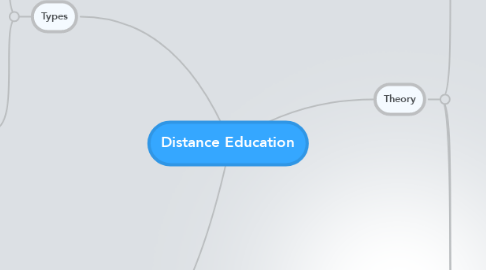
1. Types
1.1. Correspondence education
1.1.1. Preplanned course materials
1.1.2. Books, magazines, journals, etc.
1.1.3. Television and radio
1.1.4. Communication by telephone
1.1.5. Communication by mail/post
1.1.6. Audio and video tapes
1.2. e-Learning
1.2.1. Computer-assisted instruction
1.2.2. Online course materials
1.2.3. Communication by e-mail
1.2.4. Communication by asynchronous conference (bulletin board)
1.2.5. Communication by synchronous Web conferencing
1.2.6. Communication by online chat room
1.2.7. Online video sharing
2. Application
2.1. OMDE 601
2.1.1. Transactional Theory
2.1.1.1. High transactional distance
2.1.1.2. Low individualization
2.1.1.3. More structure
2.1.1.4. Less dialog
2.1.1.5. More autonomy
2.1.1.6. Good fit!
3. Theory
3.1. Otto Peters: Industrial Theory
3.1.1. Comparison Criteria
3.1.1.1. Rationalization
3.1.1.2. Division of labor
3.1.1.3. Assembly line
3.1.1.4. Prepatory work
3.1.1.5. Specialization
3.1.1.6. Mechanization, automation; virtualization
3.1.1.7. New forms of energy
3.1.1.8. Planning
3.1.1.9. Controlling
3.1.1.10. Formalization
3.1.1.11. Standardization
3.1.1.12. Change of functions
3.1.1.13. Time-space separation
3.1.1.14. Objectifying
3.1.1.15. Capital-intensive techniques
3.1.1.16. Mass production
3.1.1.17. Mass distribution
3.1.1.18. Concentration
3.1.1.19. Centralization
3.1.2. Dimensions
3.1.2.1. Historical
3.1.2.2. Cultural
3.1.2.3. Anthropological
3.1.2.4. Sociological
3.1.2.5. Educational
3.1.2.6. Economic
3.1.2.7. Pedagogical
3.2. Michael Grahame Moore: Transactional Theory
3.2.1. Transactional distance
3.2.2. Individualization
3.2.3. Structure
3.2.4. Dialog
3.2.5. Autonomy
3.2.5.1. Execution
3.2.5.2. Evaluation
3.2.5.3. Goals
3.3. Borje Holmberg: Empathetic Teaching-Learning Conversation
3.3.1. Empathetic conversation with students
3.3.2. Support study motivation
3.3.2.1. Friendly atmosphere
3.3.2.2. Helpful suggestions
3.3.2.3. Encouragement
3.3.3. Apply ideas from traditional education
3.3.4. Engage student in decision making
3.3.5. Style of presentation
3.3.5.1. Lucid
3.3.5.2. Problem-oriented
3.3.5.3. Conversation-like
